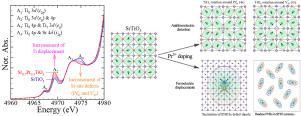杂价掺杂初期铁电体中极性纳米区形成机理
IF 9.3
1区 材料科学
Q1 MATERIALS SCIENCE, MULTIDISCIPLINARY
引用次数: 0
摘要
初始铁电性SrTiO3被称为钛的铁电极性位移和TiO6八面体的抗铁畸变(AFD)旋转之间的结构竞争。掺pr的SrTiO3 (SPTO)具有弛豫型铁电性,同时表现出增强的铁电极性和抗铁畸变。本文采用双边缘x射线吸收光谱精细结构(XAFS: XANES & EXAFS)研究了SPTO弛豫剂的局部结构以及这两种结构畸变的共存性质。Ti K-edge XANES光谱A2峰的增加观察到局地极性增强,其强度与Ti的位移值成正比。通过对Ti k -边缘EXAFS光谱的几何分析,得到了Ti位移的精确值。Sr k边EXAFS结果表明,Pr的掺入增加了TiO6八面体的AFD旋转角度。借助于不灭算,Ti - K-edge XANES的A4峰下降证实了Sr2+位(PrSr•)上Pr3+取代后电荷补偿产生的VSr”的存在。这些结果解释了SPTO弛豫器中铁电极性和反铁畸变的同时增强源于PrSr•和VSr”点缺陷的共同作用。在此基础上,提出了SPTO弛豫器中PNR形成的结构机制。本研究阐明了SrTiO3中杂价掺杂诱导弛豫性质的机理,为通过掺杂工程在其他早期铁电体中诱导弛豫性质奠定了基础。本文章由计算机程序翻译,如有差异,请以英文原文为准。


Formation mechanism of polar nanoregion in heterovalent doped incipient ferroelectrics
Incipient ferroelectric SrTiO is known as the structural competition between the ferroelectric polar displacement of Ti ion and antiferrodistortive (AFD) rotation of TiO octahedron. Pr-doped SrTiO (SPTO) possesses relaxor-type ferroelectricity and exhibits both enhanced ferroelectric polar and antiferrodistortion. Here, we use double-edge X-ray absorption spectroscopy fine structure (XAFS: XANES & EXAFS) to investigate the local structure of the SPTO relaxor and the co-existing nature of these two structural distortions. The enhanced local polar is observed by the increment of the A peak of Ti -edge XANES spectra, whose intensity is proportional to the displacement value of the Ti ion. The exact value of Ti displacement is obtained by geometrical analysis of the Ti -edge EXAFS spectra. Sr -edge EXAFS results show the angle of the AFD rotation of TiO octahedron is also increased with Pr doping. With the help of the calculation, the existence of V, which is produced by charge compensation after the substitution of Pr on the Sr site (Pr), is confirmed by the decreased A peak of Ti -edge XANES. These results explain that the simultaneous enhancement of the ferroelectric polar and the antiferrodistortion in the SPTO relaxor originates from the co-work of the point defects of Pr and V. Based on our results, a structural mechanism of the PNR formation in the SPTO relaxor is proposed. This study elucidates the mechanism of the heterovalent doping-induced relaxor property in SrTiO and paves the way to induce relaxor property in other incipient ferroelectrics by doping engineering.
求助全文
通过发布文献求助,成功后即可免费获取论文全文。
去求助
来源期刊

Acta Materialia
工程技术-材料科学:综合
CiteScore
16.10
自引率
8.50%
发文量
801
审稿时长
53 days
期刊介绍:
Acta Materialia serves as a platform for publishing full-length, original papers and commissioned overviews that contribute to a profound understanding of the correlation between the processing, structure, and properties of inorganic materials. The journal seeks papers with high impact potential or those that significantly propel the field forward. The scope includes the atomic and molecular arrangements, chemical and electronic structures, and microstructure of materials, focusing on their mechanical or functional behavior across all length scales, including nanostructures.
 求助内容:
求助内容: 应助结果提醒方式:
应助结果提醒方式:


